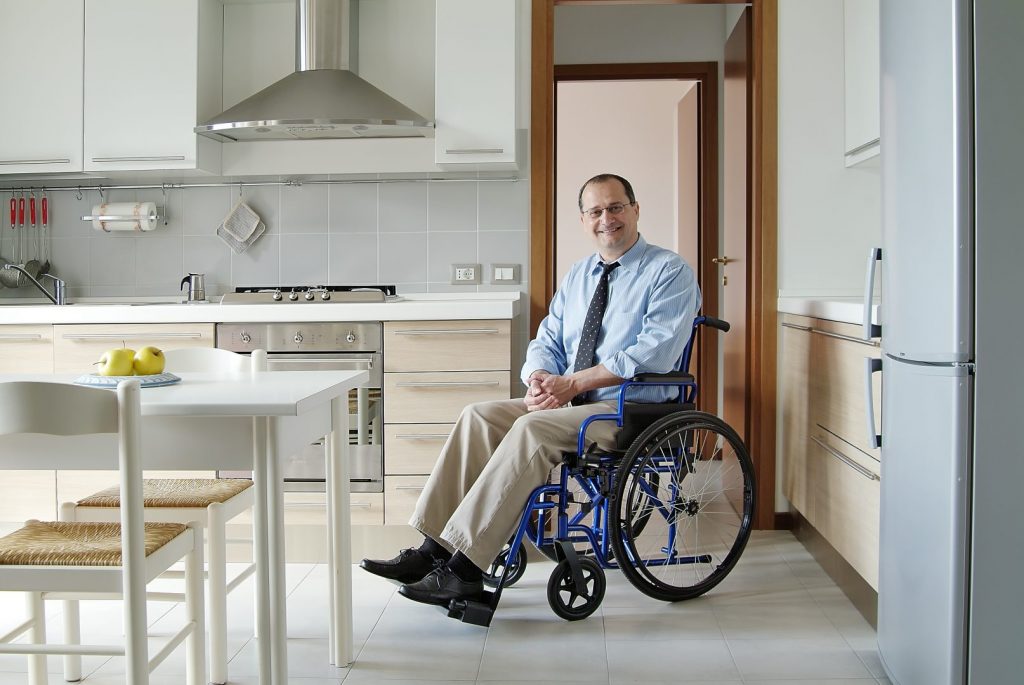
This male wheelchair user seen in his kitchen has access to what he requires to take care of his needs because of thoughtful universal design considerations
While aging in place designs are specific to the client’s needs, the individual household we are working in, and the characteristics of that particular home, there are many elements we can include from a universal design standpoint that are going to facilitate aging in place and enhance visitability. After all, social connections are very important for people of all ages but especially as they get older – to remain connected to the outside world, to have someone physically to talk with and interact and to remove any fears of isolation or solitude.
By approaching a home renovation with universal design strategies, we are going to be installing a foundational framework of accessible and usable solutions that are going to enable the majority of people coming into that space, as well as those living there, to interact well with the home.
Universal design goes beyond just solutions and functional elements to styling so that anything incorporated into the home fits into that space as though its always been there and as an integral part of the design. It doesn’t distinguish itself as an add-on or as anything special except that someone might remark on how attractive it is or what a nice design it is.
We have a choice when we are creating renovations in someone’s home, regardless of what it is and their budget. It can serve the intended purpose regardless of how universal or unobtrusive it is in appearance to those not familiar with the home or the reasons for the renovations, or we can create it in such a way as to make it functional for the client and other members of the family as necessary and have it fit into the home environment as if it has been there all along. Some needs-specific improvements may require us to be a little more obvious in our solutions, but the ideal is to have them fit in and be of a universal design in nature.
If we recall the seven principles of universal design created by North Carolina State University in 1997, from each other, the first objective is having something of equitable use, meaning that it takes no special or trained skill or ability to operate the object or feature in question. This is one of the chief ways we begin to level the playing field for aging in place designs. When it doesn’t matter what someone’s physical size or ability is, their age, whether they are standing or seated (or supporting themselves with a cane, crutches, or a walker), or any other differences they may have from each other, and our design treatment can be characterized as being of equitable use, all can use it.
The degree of difficulty someone may have in getting around or experiencing their environment is irrelevant as far as using the design so created for the space. The more we can do this, the more our aging in place designs are going to be consistent with universal design strategies and the more even the opportunities for everyone to use them are going to be, without any regard or consideration for differing needs or abilities.
While all seven principles of universal design underscore how aging in place can be facilitated if not completely accommodated through the use of universal design, the fifth principle (tolerance for error) and the sixth one (low physical effort) work with the principle of equitable use to illustrate just how easily we can accommodate people who might be experiencing limitations or other issues in their lives that need specialized treatments.
When we use design elements, solutions, or treatments that anyone can use regardless of their need or ability (equitable use), and they can use them to the best of their ability since they don’t have to be used in a prescribed way as long as they can make them work (tolerance for error) – such as operating a faucet or turning on a light switch, plus it requires little physical effort to use them – making it ideal for someone to use that has limited hand or arm strength, reach, range of motion, or grasping ability.
The point is that universal design applications facilitate aging in place lifestyles by creating a baseline environment that anyone can use well. When there are special needs beyond that which universal design features will accommodate, we can address them specifically, but the majority of those requirements are likely to be met just through the adoption and use of universal design features wherever and whenever we have the opportunity to employ them. We don’t have to announce to our clients what we are doing or why, we just have to create suitable designs, and they quite often will be universal in nature. This is how we can level or shrink the playing field to accommodate most anyone.
